
Maximize Comfort and Savings with Energy-Efficient Devices
Takeaways: Energy-efficient devices, such as smart thermostats, not only help in reducing energy consumption but also offer increased comfort and convenience. By investing in these technologies, homeowners can significantly lower their utility bills and contribute to a more sustainable future.
As concerns about climate change and rising energy costs grow, many homeowners are turning to energy-efficient devices to help manage their energy consumption. One of the most popular and effective options available today is the smart thermostat. These devices not only provide the convenience of remote climate control but also optimize energy usage, leading to substantial savings on energy bills. This article will explore the benefits of energy-efficient devices, focusing particularly on smart thermostats.
Understanding Energy-Efficient Devices

Smart thermostats, for instance, allow users to control their home’s heating and cooling systems remotely via smartphone apps or voice-activated assistants. They learn user preferences over time and can adjust settings automatically based on occupancy and weather conditions. This level of automation not only enhances comfort but also significantly reduces energy use, which can lead to lower utility bills.
The Benefits of Smart Thermostats

1. Energy Savings
One of the primary reasons homeowners invest in smart thermostats is their potential for energy savings. According to the U.S. Environmental Protection Agency (EPA), homeowners can save an average of 10-15% on heating and cooling costs by utilizing a programmable thermostat. With smart thermostats, these savings can be even greater, as they adjust temperatures based on real-time data and user habits, ensuring that energy is not wasted when the home is unoccupied.
2. Enhanced Comfort
Smart thermostats provide a level of comfort that traditional thermostats cannot match. They allow users to set specific schedules and temperatures for different times of the day, ensuring a comfortable environment when people are home while saving energy when they are away. Many models also feature geofencing technology, which adjusts the temperature based on the homeowner’s location, ensuring that the home is always at the perfect temperature upon arrival.
3. Remote Control and Monitoring
With smart thermostats, homeowners can control their heating and cooling systems from anywhere using a smartphone, tablet, or computer. This remote access allows users to make adjustments on the go, ensuring that they can respond to changes in their schedule or unexpected weather conditions. Additionally, many smart thermostats provide energy usage reports, helping homeowners understand their consumption patterns and identify further savings opportunities.
4. Integration with Smart Home Systems
Smart thermostats can easily integrate with other smart home devices, creating a cohesive and efficient home automation system. For instance, they can work alongside smart lighting systems, security cameras, and voice-activated assistants, allowing for seamless control and enhanced energy efficiency throughout the home.
5. Environmental Impact
By reducing energy consumption, smart thermostats help decrease greenhouse gas emissions associated with electricity generation. This is particularly important in the fight against climate change. Choosing energy-efficient devices like smart thermostats contributes to a more sustainable future, making it an excellent choice for environmentally conscious homeowners.
Conclusion







